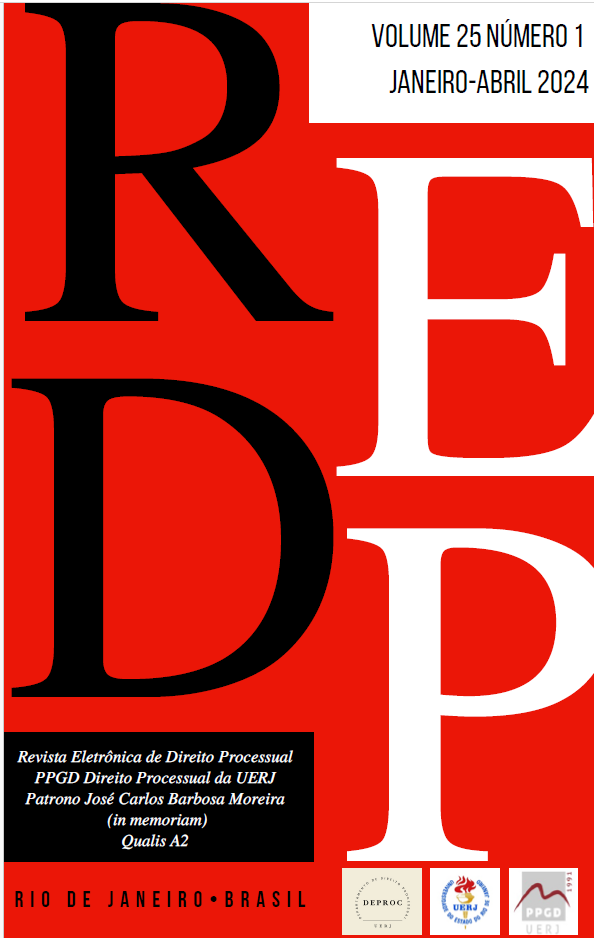A TRAJETÓRIA NORMATIVA DA MEDIAÇÃO: UM DIÁLOGO ENTRE BRASIL E ITÁLIA
DOI:
https://doi.org/10.12957/redp.2024.81923Resumo
A retomada contemporânea da mediação é um processo diversificado e que sofre significativa influência dos sistemas jurídicos nacionais existentes em cada país. É importante reconhecer que a diversificação das práticas de mediação nos diferentes países se singulariza a partir de dois fatores que se pode destacar como determinantes: o contexto histórico de desenvolvimento da mediação e a regulamentação normativa. Dito isso, o artigo tem como objetivo principal analisar o desenvolvimento da mediação na Itália, com enfoque na regulação normativa, a fim de promover diálogo com a mediação no Brasil. Nessa perspectiva, a presente pesquisa se justifica pela semelhança entre os sistemas de regulação social do Brasil e da Itália, visto que ambos podem ser considerados como Estados que constituem exemplos típicos de países que adotam como matriz jurídica o civil law. Assim, faz-se uma importante contraposição ao modelo norte-americano de mediação, alicerçado em sistema jurídico característico do common law. Nesse sentido, o trabalho busca responder ao seguinte problema: quais as singularidades do percurso normativo da mediação no Brasil e na Itália? Para tanto, foi realizado um estudo descritivo, com abordagem comparativa, sobre o desenvolvimento do instituto da mediação no Brasil e na Itália, com especial destaque para a análise do contexto histórico e dos marcos normativos. Ao final, foi possível identificar: a influência do modelo norte-americano no desenvolvimento da mediação no Brasil e na Itália; a origem externa ao Poder Legislativo nacional da regulamentação normativa do instituto; significativas diferenças conceituais sobre a mediação e conciliação; por fim, a existência de distintas possibilidades de emprego do instituto, segundo a natureza dos direitos objeto do conflito. Assim, apesar da similaridade dos sistemas jurídicos, e da forte influência estadunidense, pode-se concluir que a mediação no Brasil e na Itália se desenvolveu de maneira bastante singular em cada um dos países, apresentando apenas alguns pontos de contato.
Publicado
Versões
- 2024-02-07 (3)
- 2024-02-07 (2)
- 2024-02-07 (1)
Como Citar
Edição
Seção
Licença
Copyright (c) 2024 Tássio Túlio Braz Bezerra, Fabiana Marion Spengler

Este trabalho está licenciado sob uma licença Creative Commons Attribution 4.0 International License.
Todos os artigos publicados na Revista Eletrônica de Direito Processual (REDP) (Departamento de Direito Processual, Universidade do Estado do Rio de Janeiro, Brasil) são licenciados por meio de uma Licença Creative Commons - Atribuição 4.0 Internacional (CC BY 4.0).
Os autores retêm os direitos autorais de seu artigo e concordam em licenciar seu trabalho com a licença CC BY 4.0, aceitando assim os termos e condições específicos desta licença disponíveis no seguinte website: https://creativecommons.org/licenses/by/4.0/legalcode.
- Os autores concedem à REDP o direito de primeira publicação, de se identificar como publicadora original do trabalho e concedem à revista uma licença de direitos não exclusivos para utilizar o trabalho das seguintes formas: Reproduzir, vender e distribuir cópias eletrônicas ou impressas do manuscrito como um todo, de partes específicas do manuscrito e de suas traduções para qualquer idioma;
- O uso do artigo por terceiros é livre, contanto que a integridade da publicação seja mantida e seus autores originais, periódico de primeira publicação e detalhes de citação sejam identificados.
Dentro dos termos da licença, os autores podem entrar em acordos contratuais adicionais separados para a distribuição não exclusiva da versão publicada do trabalho na revista.
Copyright and Licensing
All articles published in the Procedural Law Electronic Review (REDP) (Department of Procedural Law, State University of Rio de Janeiro, Brazil) are licensed under a Creative Commons License - Attribution 4.0 International (CC BY 4.0).
- Authors retain copyright to their article and agree to license their work under the CC BY 4.0 license, thereby accepting the specific terms and conditions of this license available at the following website: https://creativecommons.org/licenses/by/4.0/ legal code.
- Authors grant REDP the right of first publication, to identify itself as the original publisher of the work, and grant the journal a non-exclusive license to use the work in the following ways: Reproduce, sell and distribute electronic or printed copies of the manuscript as a whole, of specific parts of the manuscript and its translations into any language;
- Use of the article by third parties is free, as long as the integrity of the publication is maintained and its original authors, first publication journal, and citation details are identified.
Within the terms of the license, authors may enter into separate additional contractual agreements for the non-exclusive distribution of the published version of the work in the journal.




